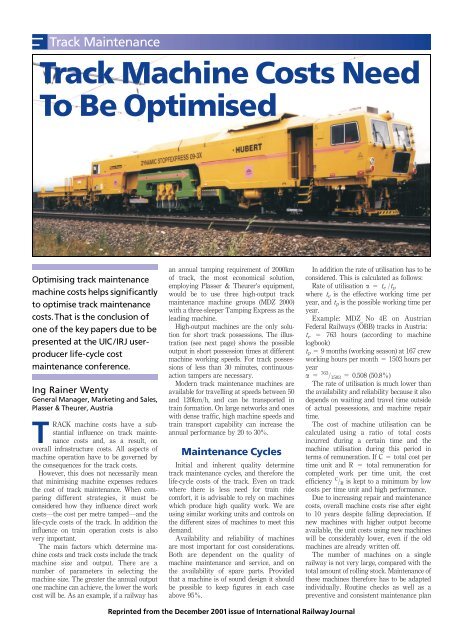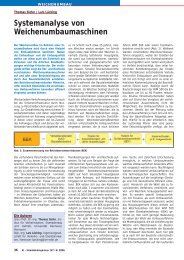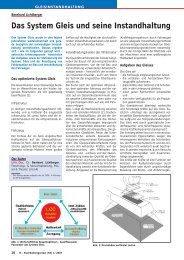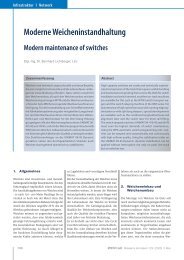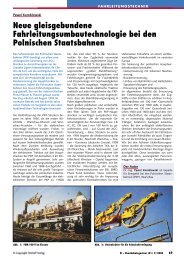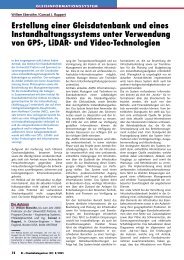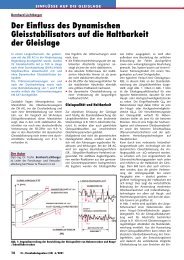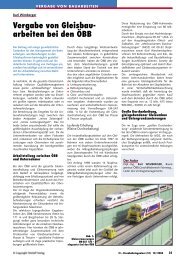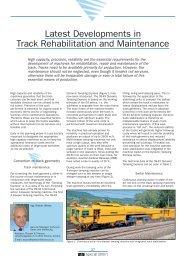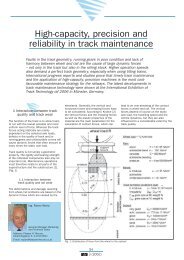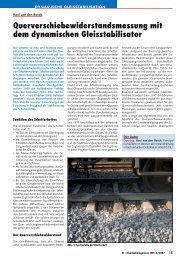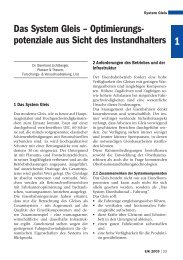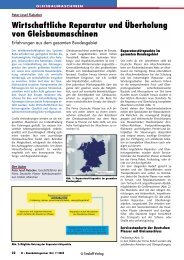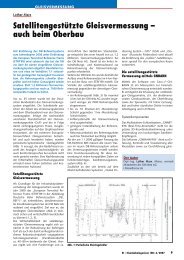Track Machine Costs Need To Be Optimised - Plasser & Theurer
Track Machine Costs Need To Be Optimised - Plasser & Theurer
Track Machine Costs Need To Be Optimised - Plasser & Theurer
Create successful ePaper yourself
Turn your PDF publications into a flip-book with our unique Google optimized e-Paper software.
<strong>Track</strong> Maintenance<br />
<strong>Track</strong> <strong>Machine</strong> <strong>Costs</strong> <strong>Need</strong><br />
<strong>To</strong> <strong>Be</strong> <strong>Optimised</strong><br />
Optimising track maintenance<br />
machine costs helps significantly<br />
to optimise track maintenance<br />
costs.That is the conclusion of<br />
one of the key papers due to be<br />
presented at the UIC/IRJ userproducer<br />
life-cycle cost<br />
maintenance conference.<br />
Ing Rainer Wenty<br />
General Manager, Marketing and Sales,<br />
<strong>Plasser</strong> & <strong>Theurer</strong>, Austria<br />
TRACK machine costs have a substantial<br />
influence on track maintenance<br />
costs and, as a result, on<br />
overall infrastructure costs. All aspects of<br />
machine operation have to be governed by<br />
the consequences for the track costs.<br />
However, this does not necessarily mean<br />
that minimising machine expenses reduces<br />
the cost of track maintenance. When comparing<br />
different strategies, it must be<br />
considered how they influence direct work<br />
costs—the cost per metre tamped—and the<br />
life-cycle costs of the track. In addition the<br />
influence on train operation costs is also<br />
very important.<br />
The main factors which determine machine<br />
costs and track costs include the track<br />
machine size and output. There are a<br />
number of parameters in selecting the<br />
machine size. The greater the annual output<br />
one machine can achieve, the lower the work<br />
cost will be. As an example, if a railway has<br />
an annual tamping requirement of 2000km<br />
of track, the most economical solution,<br />
employing <strong>Plasser</strong> & <strong>Theurer</strong>’s equipment,<br />
would be to use three high-output track<br />
maintenance machine groups (MDZ 2000)<br />
with a three-sleeper Tamping Express as the<br />
leading machine.<br />
High-output machines are the only solution<br />
for short track possessions. The illustration<br />
(see next page) shows the possible<br />
output in short possession times at different<br />
machine working speeds. For track possessions<br />
of less than 30 minutes, continuousaction<br />
tampers are necessary.<br />
Modern track maintenance machines are<br />
available for travelling at speeds between 50<br />
and 120km/h, and can be transported in<br />
train formation. On large networks and ones<br />
with dense traffic, high machine speeds and<br />
train transport capability can increase the<br />
annual performance by 20 to 30%.<br />
Maintenance Cycles<br />
Initial and inherent quality determine<br />
track maintenance cycles, and therefore the<br />
life-cycle costs of the track. Even on track<br />
where there is less need for train ride<br />
comfort, it is advisable to rely on machines<br />
which produce high quality work. We are<br />
using similar working units and controls on<br />
the different sizes of machines to meet this<br />
demand.<br />
Availability and reliability of machines<br />
are most important for cost considerations.<br />
Both are dependent on the quality of<br />
machine maintenance and service, and on<br />
the availability of spare parts. Provided<br />
that a machine is of sound design it should<br />
be possible to keep figures in each case<br />
above 95%.<br />
In addition the rate of utilisation has to be<br />
considered. This is calculated as follows:<br />
Rate of utilisation a = t e /t p<br />
where t e is the effective working time per<br />
year, and t p is the possible working time per<br />
year.<br />
Example: MDZ No 4E on Austrian<br />
Federal Railways (O¨ BB) tracks in Austria:<br />
t e = 763 hours (according to machine<br />
logbook)<br />
t p = 9 months (working season) at 167 crew<br />
working hours per month = 1503 hours per<br />
year<br />
a = 763 / 1503 = 0.508 (50.8%)<br />
The rate of utilisation is much lower than<br />
the availability and reliability because it also<br />
depends on waiting and travel time outside<br />
of actual possessions, and machine repair<br />
time.<br />
The cost of machine utilisation can be<br />
calculated using a ratio of total costs<br />
incurred during a certain time and the<br />
machine utilisation during this period in<br />
terms of remuneration. If C = total cost per<br />
time unit and R = total remuneration for<br />
completed work per time unit, the cost<br />
efficiency C / R is kept to a minimum by low<br />
costs per time unit and high performance.<br />
Due to increasing repair and maintenance<br />
costs, overall machine costs rise after eight<br />
to 10 years despite falling depreciation. If<br />
new machines with higher output become<br />
available, the unit costs using new machines<br />
will be considerably lower, even if the old<br />
machines are already written off.<br />
The number of machines on a single<br />
railway is not very large, compared with the<br />
total amount of rolling stock. Maintenance of<br />
these machines therefore has to be adapted<br />
individually. Routine checks as well as a<br />
preventive and consistent maintenance plan<br />
Reprinted from the December 2001 issue of International RailwayJournal
<strong>Track</strong> Maintenance<br />
‘‘Routine checks as well<br />
as a preventive and<br />
consistent maintenance<br />
plan are a basic<br />
requirement for the<br />
reliable use of a track<br />
maintenance machine.’’<br />
Rainer Wenty<br />
are a basic requirement for the reliable use<br />
of a track maintenance machine.<br />
Although general maintenance schedules<br />
are part of the operator’s manual, it is not<br />
enough to rely on schedules. Experienced<br />
machine operators can detect imminent<br />
failures just as they begin to develop and<br />
can prevent costly machine breakdown by<br />
timely exchange of failing parts. Most<br />
successful is the concept of operator maintainers.<br />
Additionally, efforts should be made<br />
by the machine owner to make it attractive<br />
for an operator to retain a certain machine<br />
for at least a couple of years.<br />
For more complex repairs a ‘‘fall-back’’<br />
solution is necessary, which can employ inhouse<br />
experts or service engineers from the<br />
supplier. Our worldwide service network<br />
can make service engineers available in a<br />
short time.<br />
Quick spare parts supply is also essential<br />
because machine down time caused by a<br />
lack of spare parts can be very expensive.<br />
While we strive to supply original parts<br />
promptly, the machine owner should also<br />
keep a stock of frequently-used parts.<br />
<strong>Machine</strong> projects which are financed by<br />
international development banks should<br />
make a provision for an initial stock of<br />
OUTPUT VERSUS POSSESSION TIME<br />
parts, and for the purchase of parts which<br />
fail unexpectedly.<br />
The ownership of track maintenance<br />
machines is another point of discussion.<br />
We have seen a slight increase in ‘‘private’’<br />
orders for our equipment, and the share of<br />
machinery supplied to contractors is now<br />
about 30%. In the interests of modernisation,<br />
contractors need long-term contracts<br />
because the market is very limited and does<br />
not provide many alternatives.<br />
Outsourcing services for track maintenance<br />
machines to an outside company is an<br />
interesting alternative for the railway as a<br />
machine owner. But much depends on the<br />
capability of the company’s workshops,<br />
service technicians and management.<br />
Service technicians for maintenance machines<br />
have to be qualified in several fields,<br />
and it is often not viable for railway<br />
operators to pay for these experts themselves.<br />
<strong>Plasser</strong> & <strong>Theurer</strong> has therefore set<br />
up service support companies to provide<br />
support during the guarantee period. Other<br />
services can also be ordered at fixed rates.<br />
Service support contracts are advisable,<br />
particularly for those government-owned<br />
railways which cannot order services<br />
quickly.<br />
IRJ<br />
2000<br />
1750<br />
09-3X - 2200m/h<br />
Output (m)<br />
1500<br />
1250<br />
1000<br />
750<br />
500<br />
250<br />
0<br />
Travel and<br />
set-up time<br />
0 10 20 30 40 50 60<br />
Possession time (min)<br />
Duomatic 09-32 - 1500m/h<br />
09-16 CAT - 900m/h<br />
Standard Tamper - 600m/h<br />
Reprinted from the December 2001 issue of International RailwayJournal


